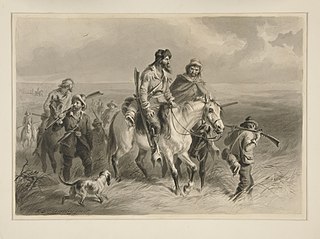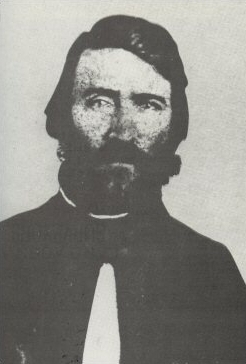
Franklin County is a county located in the eastern portion of the U.S. state of Kansas. Its county seat and most populous city is Ottawa. As of the 2020 census, the county population was 25,996. The county was named for Benjamin Franklin, a founding father of the United States. Formerly it was considered part of the Kansas City metropolitan area, but was removed in 2013.

Lecompton is a city in Douglas County, Kansas, United States. As of the 2020 census, the population of the city was 588. Lecompton was the de jure territorial capital of Kansas from 1855 to 1861, and the Douglas County seat from 1855 to 1858. Anti-slavery Lawrence became the de facto capital during the latter part of this period, when the county seat was moved there. This time period was known as Bleeding Kansas, due to the violence perpetrated by the pro-slavery, and to a lesser extent the anti-slavery, factions in the eastern part of the state. Lecompton was a hotbed of pro-slavery sentiment during the mid-1800s.

Bleeding Kansas, Bloody Kansas, or the Border War was a series of violent civil confrontations in Kansas Territory, and to a lesser extent in western Missouri, between 1854 and 1859. It emerged from a political and ideological debate over the legality of slavery in the proposed state of Kansas.

The Territory of Kansas was an organized incorporated territory of the United States that existed from May 30, 1854, until January 29, 1861, when the eastern portion of the territory was admitted to the Union as the free state of Kansas.

The Lecompton Constitution (1858) was the second of four proposed constitutions for the state of Kansas. Named for the city of Lecompton where it was drafted, it was strongly pro-slavery. It never went into effect.

Border ruffians were proslavery raiders who crossed into the Kansas Territory from Missouri during the mid-19th century to help ensure the territory entered the United States as a slave state. Their activities formed a major part of a series of violent civil confrontations known as "Bleeding Kansas", which peaked from 1854 to 1858. Crimes committed by border ruffians included electoral fraud, intimidation, assault, property damage and murder; many border ruffians took pride in their reputation as criminals. After the outbreak of the American Civil War in 1861, many border ruffians fought on the side of the Confederate States of America as irregular bushwhackers.

The Topeka Constitutional Convention met from October 23 to November 11, 1855 in Topeka, Kansas Territory, in a building afterwards called Constitution Hall. It drafted the Topeka Constitution, which banned slavery in Kansas, though it would also have prevented free blacks from living in Kansas. The convention was organized by Free-Staters to counter the pro-slavery Territorial Legislature elected March 5, 1855, in polling tainted significantly by electoral fraud and the intimidation of Free State voters.

Shawnee Methodist Mission, also known as the Shawnee Mission, which later became the Shawnee Indian Manual Labor School, is located in Fairway, Kansas, United States. Designated as a National Historic Landmark in 1968, the Shawnee Methodist Mission is operated by the city as a museum. The site is owned by the Kansas Historical Society and administered as the Shawnee Indian Mission State Historic Site.

The Kansas Legislature is the state legislature of the U.S. state of Kansas. It is a bicameral assembly, composed of the lower Kansas House of Representatives, with 125 state representatives, and the upper Kansas Senate, with 40 state senators. Representatives are elected for two-year terms, senators for four-year terms.

Pawnee is a ghost town in Geary County, Kansas, United States, which briefly served as the first official capital of the Kansas Territory in 1855. Pawnee was the territorial capital for exactly five days – the legislature met there from July 2 to July 6 – before legislators voted to move the capital to Shawnee Mission, which is located in present-day Fairway. It may be the shortest-lived capital of any U.S. state or territory.
The Nebraska Territorial Legislature was held from January 16, 1855, until February 18, 1867, in Omaha City, Nebraska Territory.

Oregon's Territorial Legislature was a bicameral legislative body created by the United States Congress in 1848 as the legislative branch of the government of the Oregon Territory. The upper chamber Council and lower chamber House of Representatives first met in July 1849; they served as the region's legislative body until Oregon became a state in February 1859, when they were replaced by the bicameral Oregon State Legislature.
Cofachique is a ghost town situated along the Neosho River near the present-day city of Iola in Allen County, Kansas, United States. Being the first town established in Allen County in 1855, it was the original county seat. However, within five years the greater part of the town was moved to the new town of Iola, while the old site of Cofachique became farm land. The town was named in honor of an Osage chief known as Cofachique, who is said to have been particularly helpful to early settlers, bringing aid to the distressed and homeless. The name "Cofachique" appears to have origins with the Cofachiqui tribe in South Carolina, who were Siouan speakers, and the Osage who settled this area were closely affiliated with the Siouan.

Peoria Township is a township in Franklin County, Kansas, USA. As of the 2000 census, its population was 626. Peoria Township has two unincorporated towns: Peoria and Imes.

Lecompton Constitution Hall, also known as Constitution Hall, is a building in Lecompton, Kansas, that played an important role in the long-running Bleeding Kansas crisis over slavery in Kansas. It is operated by the Kansas Historical Society as Constitution Hall State Historic Site.

Centropolis is an unincorporated community in Franklin County, Kansas, United States. As of the 2020 census, the population of the community and nearby areas was 100. It is located about 11 miles northwest of Ottawa. In the 1850s, Centropolis had the distinction of briefly vying for territorial capital of Kansas.

The 1st Minnesota Legislature first convened on December 2, 1857. The 37 members of the Minnesota Senate and the 80 members of the Minnesota House of Representatives were elected during the General Election of October 13, 1857. Although the Constitution of the State of Minnesota, which had been adopted by the voters at the 1857 general election, was not ratified by the United States Senate until May 11, 1858, this was the first legislature of the State of Minnesota to convene in conformity with the state constitution.

Samuel Jefferson Jones was a pro-slavery settler who held the position of Douglas County sheriff in Kansas Territory from late 1855 until early 1857. He helped found the territorial capital of Lecompton and played a prominent role in the "Bleeding Kansas" conflict.
Under U.S. law, a state requires a constitution. A main order of business for Territorial Kansas was the creation of a constitution, under which Kansas would become a state. Whether it would be a slave state or a free state, allowing or prohibiting slavery, was a national issue, because it would affect voting in the polarized U.S. Senate. Because of tensions over slavery, four quite different constitutions of Kansas were drafted.

Nathaniel Holly Gates, also known as Colonel Gates for most of his life, (1811–1889) was an American pioneer lawyer and Oregon state legislator. He was an active Democrat throughout his life. He served four terms in Oregon's territorial legislature. This included one term as Speaker of the Oregon House of Representatives during the 1858 legislative session. After Oregon became a state in 1859, he served one two-year term in the Oregon House of Representatives and one four-year term in the Oregon State Senate. Before immigrating to Oregon, Gates lived and worked as a lawyer in Ohio and Iowa. After moving to Oregon, he settled in The Dalles and opened a law practice there. He helped develop that community and served as the city's mayor five times in non-consecutive terms.



















